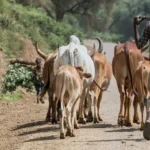In 1987, the Nobel Prize-winning economist Amartya Sen showed that many famines are not caused by a lack of food production, but by a change in the incomes of poor people.
For example, a group of peasants may suffer entitlement losses when food output in their area declines, perhaps because of a local drought, even when there is no general lack of food in the country. The victims would not have the means to buy food from elsewhere, since they wouldn’t have anything much to sell to earn an income, given their own production loss. Others with more secure earnings in other occupations or in other locations may be able to get by well enough by buying food from elsewhere. Something very like this happened in the famous Wollo famine in Ethiopia in 1973, with impoverished residents of the province of Wollo unable to buy food, despite the fact that food prices in Dessie (the capital of Wollo) were no higher than in Addis Ababa and Asmera. Indeed, there is evidence of some food moving out of Wollo to the more prosperous regions of Ethiopia where people had more income to buy food.
In other cases, food prices may shoot up because of the increased purchasing power of some occupation groups, and as a result others who have to buy food may be ruined because the real purchasing power of their money incomes may have shrunk sharply. Such a famine may occur without any decline in food output, resulting as it does from a rise in competing demand rather than a fall in total supply. This is what started off the famine in Bengal in 1943, with urban dwellers gaining from the "war boom" – the Japanese army was round the corner and the British and Indian defence expenditures were heavy in urban Bengal, including Calcutta. Once the rice prices started moving up sharply, public panic as well as manipulative speculation played its part in pushing the prices sky high, beyond the reach of a substantial part of the population of rural Bengal.
What is striking about these cases is that food aid – that is, buying surplus production from rich countries and shipping it to the places where people are hungry – may do more harm than good. What the poor people need in these circumstances is buying power, to enable them to buy the food that is already being produced but is not available to them. Food aid may depress local food prices, and thereby cause some harm to food producers and perhaps reduce future production. In these circumstances, it would be better to drop dollar bills out of helicopters than sacks of food.
It seems that we may be in something like this situation right now in Niger. According to this news report, there is food in the markets in Niger: the problem is that the poorest people there do not have money to buy it:
Johanne Sekkenes, the mission head of MSF which is mounting the biggest emergency exercise in its history in Niger, says the current emergency could have been avoided. ‘This is not a famine, in the Somalian way,’ she said. ‘The harvest was bad in 2004 and the millet granaries are empty. Yet there is food on the markets. The trouble is that the price of the food is beyond anyone’s reach.
It has been encouraging to hear that there is now some international response to the crisis in Niger. But we we must do so in ways which deal with the real causes of the problem. Too often, our own self interest (we can provide income for our own farmers) combines with an ill-informed set of assumptions about Africa ("they can’t grow enough food to feed themselves") and leads us to support inappropriate solutions.
Hat tip: Ian





2 responses to “Famine is not usually caused by the absence of food”
Owen,
I agree of course with everything you say, but I would just add a cautionary rider that the highly publicised famine in Ethiopia in the mid-1980s (as distinct from the one ten years earlier which you mention) was mainly attributable to lack of food virtually throughout the country as a result of three successive years of drought (almost unprecedented) affecting almost every area of this large and diverse country (also extremely unusual). Moreover a high proportion of the people affected were not in a money economy and so income variation didn’t apply, except to a limited extent to barter rates. However, the shortages and starvation were undeniably aggravated to some extent by the Mengistu government’s ban on the commercial movement of food from one province to another, by extremely poor communications between different areas (many starving people had to walk for several days to get to the nearest road), by the civil wars raging in the north and parts of the south of the country (for which incidentally Mengistu and his regime were not to blame), and by years of deforestation and soil erosion caused by the unavailability in the central highlands of any kind of fuel or materials apart from trees for cooking, heating or building. The practice of keeping cows (largely as a prestige symbol) instead of growing food didn’t help, either. But there can’t be any serious doubt that food aid on a large scale was essential if several million people were not to starve. Very little of the food aid supplied was diverted and there was almost no local food market to disrupt.
This hasn’t stopped some people making extraordinary allegations about the 1980s Ethiopian famine relief programme, even suggesting that LiveAid and the other ngos ‘did more harm than good’ — and this rubbish published in such august organs as Prospect magazine. You may have seen my post on this on my own blog, along with a similar exchange in the Guardian earlier.
As you rightly say, famines vary, and the response to them needs to vary, too.
Brian
The current famine of Ethiopia is 100% caused by 100% “elected” TPLF fascists. It is a result of 23 years of terrorizing Ethiopians and systematically denying land those they consider as enemies. Stalin was exporting Soviet Ukarine wheat when his people were starving to death in 1946. Similarily TPLF is exporting food to the Arabs and Indians when Ethiopians are starving to death. http://www.huffingtonpost.com/dawit-ayele-haylemariam/the-cause-ethiopias-recurrent-famine_b_8019244.html